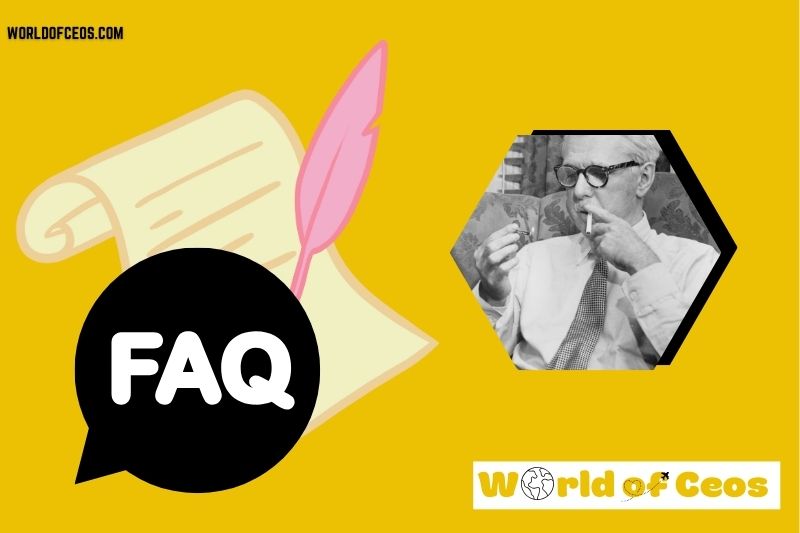James Thurber is celebrated as one of the greatest humorists of the 20th century. From his time at The New Yorker to timeless literary works like The Secret Life of Walter Mitty, Thurber’s talent translated into fame and financial success.
Understanding his journey offers insight into how humor, creativity, and hard work can lead to a lasting legacy.
This article delves into James Thurber net worth, career highlights, key achievements, and how his literary contributions shaped his finances.
Quick Facts
| FACT | DETAIL |
|---|---|
| Real Name | James Grover Thurber |
| Popular Name | James Thurber |
| Gender | Male |
| Birth Date | December 8, 1894 |
| Age | 66 (Died: November 2, 1961) |
| Parents | Charles L. Thurber, Mary Agnes Fisher Thurber |
| Siblings | Two brothers (names not specified) |
| Birthplace | Columbus, Ohio, USA |
| Nationality | American |
| Ethnicity | White |
| Education | Ohio State University (did not graduate) |
| Marital Status | Married |
| Spouse | Helen Wismer Thurber (m. 1935–1961), Althea Adams Thurber (m. 1922–1935) |
| Children | One daughter, Rosemary Thurber |
| Dating | N/A |
| Net Worth | $500,000 (equivalent to ~$4.5 million today) |
| Source of Wealth | Writing, cartooning, adaptations |
| Height | N/A |
What is the Net Worth of James Thurber in 2024?

James Thurber’s estimated net worth stood at $500,000 at the time of his death in 1961, which is approximately $4.5 million today when adjusted for inflation.
This figure reflects his earnings from writing, cartooning, and adaptations of his work, including The Secret Life of Walter Mitty.
To provide perspective, here are other notable figures in related fields:
- E. B. White
- Elliott Nugent
- Ben Stiller
- Henry Fonda
- Helen Wismer
- Marc Simont
- Harold Ross
- William Windom
- Danny Kaye
- Dorothy Parker
For more insights into the financial success of notable authors, explore our list of renowned authors.
James Thurber Salary and Finance Overview

The Journey of His Financial Success
James Thurber’s financial journey began with his contributions to The New Yorker.
As a staff writer and cartoonist, his sharp wit and unique artistic style became widely recognized.
His humorous essays, including The Night the Bed Fell and The Dog That Bit People, resonated with readers and established his reputation.
Thurber’s move into book publishing further expanded his income streams. Collections like My Life and Hard Times and Fables for Our Time were both critical and commercial successes, cementing his status as a leading literary figure.
Key Works That Defined His Career and Wealth
Thurber’s influence extended to Broadway, where he co-wrote The Male Animal with Elliott Nugent.
The play’s success led to a Hollywood adaptation, broadening his audience and financial opportunities.
His short story The Secret Life of Walter Mitty is among his most celebrated works.
It not only gained critical acclaim but was adapted into two major films, first in 1947 and then in 2013. These adaptations contributed significantly to his financial legacy.
Awards and Accolades That Boosted His Reputation
James Thurber received a Special Tony Award for his adapted script of A Thurber Carnival.
This recognition underscored his multifaceted talent and brought additional revenue from theater performances.
Thurber’s ability to traverse multiple platforms—print, stage, and screen—ensured a steady flow of financial rewards throughout his career.
Major Adaptations and Their Financial Influence
The cinematic adaptations of The Secret Life of Walter Mitty remain standout examples of how his work reached global audiences.
Such adaptations not only revived interest in his stories but also boosted his posthumous earnings through royalties.
Additionally, his fables and essays continue to be reprinted, contributing to his enduring financial legacy.
The Influence of Literary Collaborations on His Income
Collaborations with contemporaries like E. B. White brought fresh dimensions to Thurber’s work.
White’s role in publishing Thurber’s early cartoons at The New Yorker was instrumental in shaping his career.
Similarly, his partnership with Elliott Nugent on The Male Animal demonstrated how teamwork in the creative field can yield both artistic and financial rewards.
The Lasting Legacy of His Contributions
James Thurber’s legacy continues to thrive, as his works are regularly studied, adapted, and appreciated by new generations.
His timeless humor ensures a lasting financial and cultural footprint, keeping his name relevant decades after his passing.
FAQs About James Thurber

What were James Thurber’s most famous works?
Some of his most notable works include The Secret Life of Walter Mitty, The Male Animal, and My Life and Hard Times.
Who did he collaborate with during his career?
He worked closely with E. B. White and Elliott Nugent, both of whom significantly influenced his career trajectory.
What awards did he receive?
He won a Special Tony Award for A Thurber Carnival, recognizing his contributions to theater.
How did James Thurber’s vision problems affect his career?
Thurber’s near-total blindness shaped his unique drawing style, contributing to his success as a cartoonist.
What genres did he focus on?
Thurber specialized in humor, short stories, essays, and fables, often exploring human eccentricities.
Was The Secret Life of Walter Mitty adapted into a film?
Yes, it was adapted twice—first in 1947 and later in 2013, both adaptations boosting his literary fame.
Did he work at The New Yorker?
Yes, Thurber was a staff writer and cartoonist at The New Yorker, a role that significantly shaped his career.
What was James Thurber’s educational background?
He attended Ohio State University but did not graduate due to vision issues.
Conclusion
James Thurber’s contributions to humor and literature have left an indelible mark on the world. His career achievements and financial legacy continue to inspire.
For more insights into your favorite celebrities, visit worldofceos.com, and don’t forget to share your thoughts in the comments!

